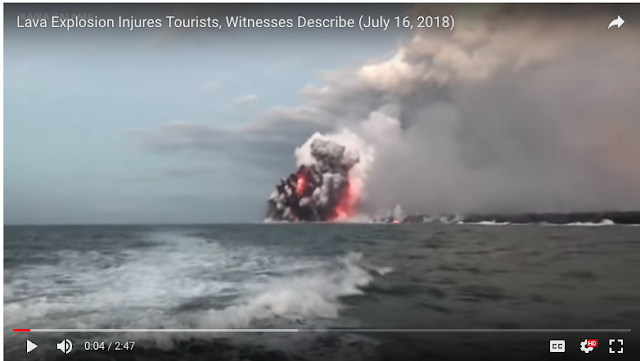Breezy trades have thankfully returned. When winds are slack up here, these days the air is...hazy. The noeuahi (volcanic haze) is laden with ultra-fine lehu (ash) and rock dust. Thankfully, after the ongoing collapses of Kaluapele and the absence of molten pele, the amount of kūkaepele (sulphur) in what we usually experience up here of uahi ʻawa (sulphur smoke or vog) is minimal. Operative phrase: Up Here. Down in Keahialaka, it is, of course a much different story. PGcam images show plumes of uahi ʻawa, that pungent bitter smoke, rising constantly. Itʻs more than unpleasant, it can be deadly. You saw that aerial photo (I think posted yesterday?) of Keahialaka? It illustrates the contrast between green/brown, clean/not clean air. If uahi ʻawa does that to plants, just imagine what it can to to your respiratory system.
So, to concerned friends and acquaintances who wonder...up here the air, the majority of the time, is excellent.
The photos below, for a variety of reasons, are informative. I took the first on January 4, 2018 during one of my walks to Keanakākoʻi. It was one of those jaw-droppingly pristinely-clear days. Slope of Maunaloa rises to the left in the background, a little bluish puff of uahi ʻawa rises from Halemaʻumaʻu at the left. Snow-capped Maunakea on the middle horizon, the dark hump of Kūlani to her right. Note that little area of blackish on my side of the rim of HMM. And to the right of the far right whiteness of the walls of HMM is, on the floor and below MKEA, the jagged black spatter rampart of the April 1982 eruption.
Below, a very similar view from July 15, 2018. The blackish area now hangs on the rim of Halemaʻumaʻu. The 1982 spatter rampart is now on a kaulu (ledge) below a brand new pali forming during continuing subsidence of the floor of Kaluapele. And if the floor below looks oddly lower than that in the upper photo...it is. Another fine example of pūʻiwa, that stupefaction on account of wonder.
And the hazy air below is that un-sulphured (for the most part) noeuahi.
Below is the KIcam view this morning at 8, looking in the opposite direction of the photos above. We donʻt need an anemometer (wind gauge) to know that itʻs windy. See the plume of tan lehu (ash) blowing to the right?
And I noted that, for some reason, my link to the Volcano House LIVE cam stopped working. If that happened to you too, hereʻs a fresh link:
VHouse LIVE camera
And, maybe because of my sometimes-befuddled state, Im thinking/feeling/hoping that ʻōlaʻi (earthquakes) up here are becoming less frequent? We can always hope... Below, from this morning, those M3 and higher for the last day. Hmmmmm
While down at Keahialaka this morning, looks like they had another overflow of the kahawai pele...that pale grey area at the right. Iʻm recalling looking earlier today and seeing the stream all whitehot. I think. Seems that overflows happen whenever...about 2 hours after an exploquake, and other times too. Just because...exploquakes, a temporary pulse or surge in supply...nothing is constant.
And yes, Iʻd be remiss if I didnʻt at least mention the explosion at the coast yesterday that injured many on a boat tour.
Explosion at ocean entry July 16, 2018
The Video from another boat as it was returning to Hilo, from Big Island Video News. Screenshot below:
And, Iʻve been saying...what??? I canʻt hear you... No Get Complacent!!!
Yes, had boat tours for a few years offshore of the park. Nothing like this happened that we know of or saw. But. Ocean floor topography is different. Lava is different (pāhoehoe there, ʻaʻā here). Volume is different. Itʻs all different. And if and when differences arenʻt noted and respected, and we get complacent, bad things can happen. I sometimes get accused of being super-cautious. Especially with active-lava related things. But when you have a decades-long history of interacting with pele, dealing with people who of course know better than you, know that folks have died over the years because of ignorance, or because people sometimes willfully ignore safety barricades, warnings, and messages and get hurt...What you going do??? Try your best to pick up the pieces, and hope that people learn. Those who endanger themselves also endanger their rescuers. Would be good if we could say...Go...Youʻre on your own. You get hurt, no expect me fo help you. But what? Cannot...How you going live with yourself? Gotta go help.
This a time of wonder and amazement. Pele is working in ways none of us have seen before. Up here, down there... Pūʻiwa! We must expect the unexpected, and behave appropriately and respectfully. SHE is in charge. Always remember that.
As always, with aloha,
BobbyC
maniniowali@gmail.com






No comments:
Post a Comment